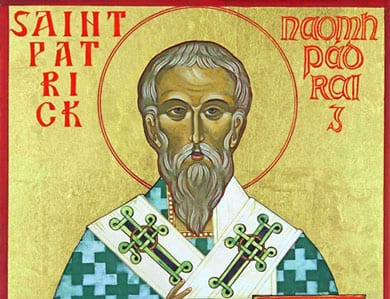 This month, we celebrate Saint Patrick’s Day. But do you know who Saint Patrick is and why we devote an entire day to his honor and remembrance?
This month, we celebrate Saint Patrick’s Day. But do you know who Saint Patrick is and why we devote an entire day to his honor and remembrance?
Taken captive
Patrick was only 16 years old when he was captured from his family’s estate in Scotland and taken to Ireland. It was the fourth century and Ireland was steeped in paganism, a nature-based cult lead by druids. There Patrick was sold as a slave to Milchu, a cruel druid priest. As a captive he learned Celtic culture, language and religion. However, it was the God of Christianity that Patrick turned to for comfort when he found himself alone in the wilderness year after year tending his master’s flocks. Though he did not have a particularly religious upbringing, Patrick became a devout Christian finding solace in a life of constant prayer and communion with God.
After six long years as a slave, God spoke to Patrick in a dream that he was to escape by way of the sea. Courageously he ran away from his captors and walked 200 miles to the sea coast. There he boarded a ship back to Scotland where he was reunited with his family.
A heart for Ireland
Though safe and free in his homeland, Patrick’s heart was still captive in Ireland. After having a dream of the Irish people calling out to him, “We appeal to you, holy servant boy, to come and walk among us,” he was determined to return to Ireland as a missionary. Patrick prepared by studying in a monastery, devoting himself to religious training for 15 years. He was ordained as a Roman Catholic priest and later consecrated as a bishop.
After two decades, Patrick finally returned to Ireland as a missionary. There he was able to use his understanding of paganism and the traditions of the Irish people to make Christianity instantly familiar to them. For example, Patrick knew that the Irish worshiped their gods with fire, so he celebrated Easter with bonfires. He also superimposed the sun, a sacred pagan symbol, on the cross to create the Celtic cross. Christianity spread quickly across the island country as Patrick spent the rest of his life there preaching, teaching and building churches, monasteries and schools.
A legend is born
Despite his years of devoted work in Ireland, Patrick died virtually unknown in his time. Only two of his letters survived, and most of the actual historical details of his life and ministry have been lost. However, as Christianity flourished and grew in Ireland, so did Patrick’s legacy. Over time, Patrick’s miracle working power has been exaggerated and spun into fantastic legends: he is said to have lit an inextinguishable fire, raised people from the dead, banished all the snakes from Ireland and to have owned a walking stick that grew into a living tree.
More probable are the stories of Patrick converting and baptizing thousands of people from all walks of life—from paupers to pagan priests to princes. His missionary work is widely credited as starting the ripple effect that resulted in the shift of Ireland from paganism to Christianity within a single century. Though Patrick was never canonized by the Roman Catholic Church, he has come to be popularly known as the Saint Patrick, the patron saint of Ireland.
Saint Patrick’s Day is officially celebrated on March 17, the day Patrick is believed to have died. With all the festivity, shamrocks and parades, it is easy to forget the true meaning of the holiday. This year, let us remember Patrick, the slave who found God while in captivity, and later returned to the land that had enslaved him to set his captors free with the gospel of Jesus Christ.
Keri is a freelance writer. She blogs regularly at keriwilliams.wordpress.com.

Comments